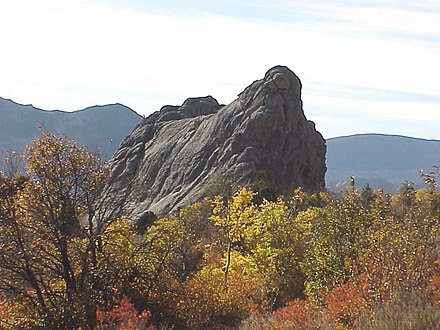The six national parks, reserves, historic sites, and monuments in Idaho contain a wide variety of interesting places and experiences. These include recreational areas, archeological sites, nature preserves and volcanic parks.
The parks
City of Rocks National Reserve
Main article: City of Rocks National ReserveDesignated as a National Reserve in 1988 and located in on the southern edge of Idaho near the Utah border (42°04′02″N 113°42′05″W / 42.067271°N 113.701399°W / 42.067271; -113.701399 (City of Rocks National Reserve)), this site is also known as the Silent City of Rocks. The park covers almost 14,000 acres (57 km) and is adjacent to Castle Rocks State Park. As its name implies, the area is notable for its rock formations and is largely composed of granitic rock; the park is a popular location for rock climbers, offering a variety of routes for climbers of different skill levels.
At the time settlers began traveling through the area the Shoshone and Bannock tribes inhabited the region. In 1826, Peter Skene Ogden and his Snake River brigade of beaver trappers were the first Euro-Americans to note the City of Rocks. However, the lack of beavers in the area caused the area to be ignored until the 1840s, when immigrant wagon trains began traveling through the area along the California Trail during the summer migration season. In 1849, a party of settlers "encamped at the city of the rocks" on the California Trail. Visitors can see marks on rock faces from axle grease. One immigrant described seeing distant rocks and said they were like "water thrown up into the air from numerous artificial hydrants." Since then the City of Rocks became a landmark for emigrants traveling along the California Trail and Salt Lake Alternate Trail.
Craters of the Moon National Monument and Preserve
Main article: Craters of the Moon National Monument and PreserveThis national park and monument is located in central Idaho (43°13′16″N 113°30′42″W / 43.221242°N 113.511654°W / 43.221242; -113.511654 (Craters of the Moon National Monument and Preserve)) along the Snake River plain. The park covers an area of 410,000 acres (1,700 km) and has an average elevation of 5,900 ft (1,800 m) The area contains different volcanic formations, basalt flows, and significant lava flows, tubes, and tree molds. Areas of sagebrush, steppe, and grassland cover a total area of 1,117 square miles (2,893 km). An area within the preserve was named a national monument on May 2, 1924 and expanded by President Bill Clinton in 2000. It currently covers parts of Blaine, Butte, Lincoln, Minidoka, and Power counties. The park was officially named Craters of the Moon National Preserve in August 2002. The park is jointly managed by the National Park Service and the Bureau of Land Management.
 A panoramic image of the Craters of the Moon
A panoramic image of the Craters of the Moon
Hagerman Fossil Beds National Monument
Main article: Hagerman Fossil Beds National MonumentLocated in south central Idaho (42°49′12″N 114°53′55″W / 42.820073°N 114.898490°W / 42.820073; -114.898490 (Hagerman Fossil Beds National Monument)), running along the west bank of the Snake River, this national park is home to a large collection of Hageraman Horse fossils. This paleontological site dates to the late Pliocene era and is known as the Hagerman Horse Quarry. The site contains many fossilized plants and animals and are considered some of the latest fossils from their era. In 1975, the archeological site was declared a National Natural Landmark by President Gerald Ford. The visitor center and museum for the park is in the town of Hagerman, Idaho, located on the east side of the Snake river, opposite the park. Developed locations for visitors to the monument and park are two overlook locations, one of the Snake river, and one overlooking a section of the historic Oregon Trail.
-
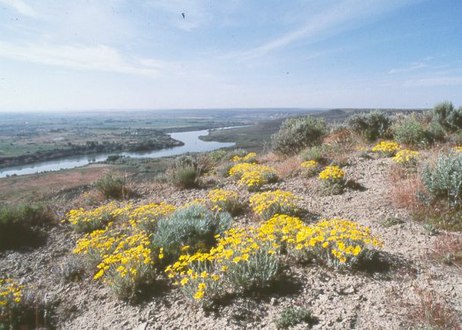 Flowers River, Hagerman National Monument.
Flowers River, Hagerman National Monument.
-
 Hagerman Horse Skeleton at Hagerman Visitors Center.
Hagerman Horse Skeleton at Hagerman Visitors Center.
-
 The Snake River at Hagerman Fossil Beds
The Snake River at Hagerman Fossil Beds
Minidoka National Historic Site
Main article: Minidoka National Historic SiteLocated in south central Idaho (42°40′44″N 114°14′38″W / 42.679°N 114.244°W / 42.679; -114.244 (Minidoka National Historic Site)), this historic site remembers the 9,000+ Japanese Americans that were unjustly imprisoned at the Minidoka Internment Camp during World War II. The camp site was placed on the National Register of Historic Places on July 10, 1979. The site measures approximately 210 acres (0.85 km).
-
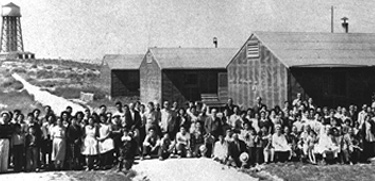 Japanese-American prisoners at Minidoka.
Japanese-American prisoners at Minidoka.
-
 The Minidoka National Historic Site.
The Minidoka National Historic Site.
-
 Minidoka Japanese American Internment Camp (1943).
Minidoka Japanese American Internment Camp (1943).
Nez Perce National Historical Park
Main article: Nez Perce National Historical ParkEstablished in 1965 and consisting of 38 individual locations spread across Idaho, Washington, Oregon, and Montana, the park preserves some of the lands originally home to the Nez Perce tribe of Native Americans. The Nez Perce National Historical Park Visitor Center () is home to a museum about the Nez Perce and their history. Since the park is spread across such as wide area, it includes several distinct ecosystems, climates and histories, each of which impacted the life of the Nez Perce.
-
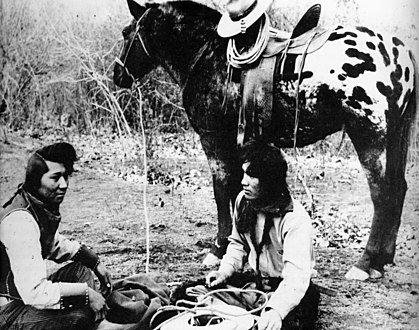 Nez Perce Indians with Appaloosa horse (c.1895).
Nez Perce Indians with Appaloosa horse (c.1895).
-
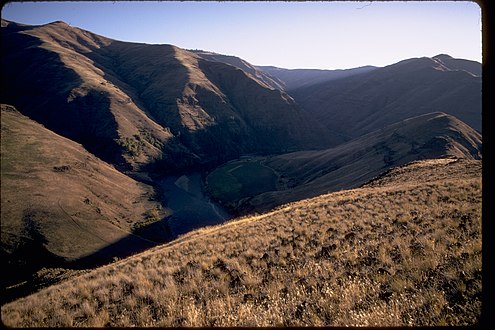 Nez Perce National Historical Park.
Nez Perce National Historical Park.
-
 Nez Perce encampment (1899).
Nez Perce encampment (1899).
Yellowstone National Park
Main article: Yellowstone National ParkEstablished by Congress in 1872, Yellowstone was the first national park established in the United States, and covers an area of 3,468.4 square miles (8,983 km); it is regarded by some as the world's first national park. Yellowstone is renowned for its geothermal landscapes and features; Old Faithful geyser is located in the park and is a key attraction at the park. Much of Yellowstone is situated on four overlapping volcanic calderas, collectively known as the Yellowstone Caldera. This vast underground system is responsible for the volcanism and geothermal activity at the park. The Greater Yellowstone Ecosystem is one of the last remaining large, nearly intact ecosystems in the northern temperate zone of the Earth. While the park is widely known for its geothermal landscapes, it contains a vast area of subalpine forests. Yellowstone's bison herds make up the largest bison population in the United States and are notable for being one of the few bison herds that has not been altered by inbreeding with cattle.
-
 Buffalo grazing at Yellowstone.
Buffalo grazing at Yellowstone.
-
 1938 poster from Yellowstone National Park.
1938 poster from Yellowstone National Park.
-
 1910 poster from Yellowstone National Park.
1910 poster from Yellowstone National Park.
-
 Geyser during an eruption.
Geyser during an eruption.
-
 Yellowstone National Park.
Yellowstone National Park.
Further reading
- Black, George (2013). Empire of Shadows: The Epic Story of Yellowstone. New York: Griffin (St. Martin’s Press). ISBN 978-1250023209.
- Josephy, Alvin M. (1997). The Nez Perce Indians and the Opening of the Northwest. Boston: Mariner Books. ISBN 978-0544310896.
- Nerburn, Kent (2005). Chief Joseph & the Flight of the Nez Perce: The Untold Story of an American Tragedy. New York: HarperOne. ISBN 978-0061136085.
- Nakadate, Neil (2013). Looking After Minidoka: An American Memoir. Bloomington: Indiana University Press. ISBN 978-0253011022.
- Quammen, David (2016). Yellowstone: A Journey Through America's Wild Heart. Washington D.C.: National Geographic. ISBN 978-1426217548.
- Shallat, Todd (2002). Secrets of the Magic Valley and Hagerman's Remarkable Horse. Boise: Black Canyon Communications. ISBN 978-0971832107.
- Tamura, Teresa (2016). Minidoka: An American Concentration Camp. Omaha: Caxton Press/University of Nebraska Press. ISBN 978-0870045738.
See also
- List of Idaho state parks
- History of the National Park Service
- List of areas in the United States National Park System
- List of national parks of the United States
- National Park Service
Notes
- Credit: Greater Yellowstone Ecosystem.
References
- ^ "City Of Rocks National Reserve". U.S. National Park Service. Retrieved August 20, 2020.
- ^ "City of Rocks National Reserve". Legends of America. Retrieved August 20, 2020.
- "Cassia Silent City of Rocks". National Natural Landmarks. National Park Service. Retrieved October 9, 2018.
- "City of Rocks". NPGallery. National Park Service. Retrieved October 9, 2018.
- "City of Rocks National Preserve". U.S. National Park Service. Retrieved August 20, 2020.
- USGS contributors. "America's Volcanic Past: Craters of the Moon National Monument". United States Geological Survey. Archived from the original on May 17, 2008. Retrieved August 20, 2020.
{{cite web}}:|author=has generic name (help) - "Craters Of The Moon National Monument & Preserve". U.S. National Park Service. Retrieved August 20, 2020.
- Henderson, Paul (1986). Craters of the Moon: Around the Loop. Craters of the Moon Natural History Association.
- Kiver, Eugene P.; Harris, David V. (1999). Geology of U.S. Parklands (5th ed.). New York: John Wiley & Sons. pp. 329–339. ISBN 978-0-471-33218-3.
- "Hagerman Fossil Beds National Monument". U.S. National Park Service. Retrieved August 20, 2020.
- "Hagerman Fossil Beds National Monument". The American Southwest. Retrieved August 20, 2020.
- "Hagerman Fossil Beds National Monument, Idaho". The American Southwest. Retrieved September 24, 2020.
- Bilal Qureshi (August 9, 2013). "From Wrong To Right: A U.S. Apology For Japanese Internment". NPR. Retrieved August 18, 2020.
- "Minidoka National Historic Site". U.S. National Park Service. Retrieved August 20, 2020.
- "Nez Perce National Historical Park". U.S. National Park Service. Retrieved August 20, 2020.
- "Yellowstone, the First National Park". Library of Congress. Archived from the original on May 11, 2017.
- "Biosphere Reserve Information – United States – Yellowstone". UNESCO – MAB Biosphere Reserves Directory. UNESCO. August 17, 2000. Archived from the original on August 4, 2007. Retrieved August 14, 2016.
- Schullery, Paul. "The Greater Yellowstone Ecosystem". Our Living Resources. U.S. Geological Survey. Archived from the original on September 27, 2006. Retrieved March 13, 2007.
- "Yellowstone Bison". National Park Service. Retrieved August 19, 2020.
- "Yellowstone National Park". U.S. National Park Service. Retrieved August 20, 2020.
External links
- National Park Service
- National Parks in Idaho, Everything Everywhere.
- NPS: Geology of Craters of the Moon.
| U.S. National Register of Historic Places | |
|---|---|
| Topics | |
| Lists by state |
|
| Lists by insular areas | |
| Lists by associated state | |
| Other areas | |
| Related | |

